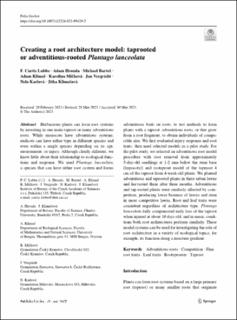| dc.description.abstract | Herbaceous plants can form root systems by investing in one main taproot or many adventitious roots. While monocots have adventitious systems, eudicots can have either type in different species and even within a single species depending on its age, environment, or injury. Although clearly different, we know little about their relationship to ecological functions and response. We used Plantago lanceolata, a species that can have either root system and forms adventitious buds on roots, to test methods to form plants with a taproot, adventitious roots, or that grow from a root fragment, to obtain individuals of comparable size. We first evaluated injury response and root traits, then used selected models in a pilot study. For the pilot study, we selected an adventitious root model procedure with root removal from approximately 5-day-old seedlings at 1-2 mm below the stem base (hypocotyl) and rootsprout model of the topmost 4 cm of the taproot from 4-week-old plants. We planted adventitious and taprooted plants in three urban lawns and harvested them after three months. Adventitious and tap-rooted plants were similarly affected by competition, producing lower biomass of leaves and stem in more competitive lawns. Root and leaf traits were consistent regardless of architecture type. Plantago lanceolata fully compensated early loss of the taproot when injured at about 10 days old, and in mesic conditions both root architectures perform similarly. These model systems can be used for investigating the role of root architecture in a variety of ecological topics, for example, its function along a moisture gradient. | en_US |

